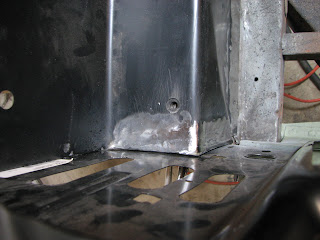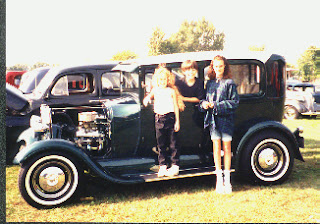It looked like Thursday night would be the night to really hit it hard and get this front end metal work knocked out. So I drilled out the 56 holes for the rosette welds using a combination of my drill press and body panel support fixture (courtesy of Eastwood) and my hand drill. The subassembly was ready finally to get installed. Here are a couple of pictures post-drill but pre-install...
I Got it measured and clamped into position. Then I started the welding. The welder however was acting up--erratic wire feed, spitting, etc. I played with it and got it to cooperate somewhat. But on the 4th weld, I pulled the trigger, got about 2 seconds of weld and then....nothing. What's going on here? I unscrewed the gas nozzle and used my nippers to grab the end of the wire, figuring it got fused in the tip. I started to pull it loose and the wire kept coming out...and coming...and coming. I opened up the welder and discovered my problem--out of wire! Bugger! So I only got this far...
I stopped by my local Thrifty Supply and picked up a spool of .023 MIG wire. I figured I was ready to go. But then I woke up in the middle of the night last night with serious chest congestion and raging sinuses. It has wiped me out. To top it off, I have a wedding today and the grass has grown from all the rain. Then I have a conference next week from Monday through Wednesday with evening meetings when I get back. I'm afraid work on the Stang will have to wait until next weekend. Oh....I forgot... The church yard sale is next Saturday.
I can't help but quot a line from SNL's Gilda Radner as Rosanne Rosanna Danna... "There's always something. If it's not one thing it's another."





















































